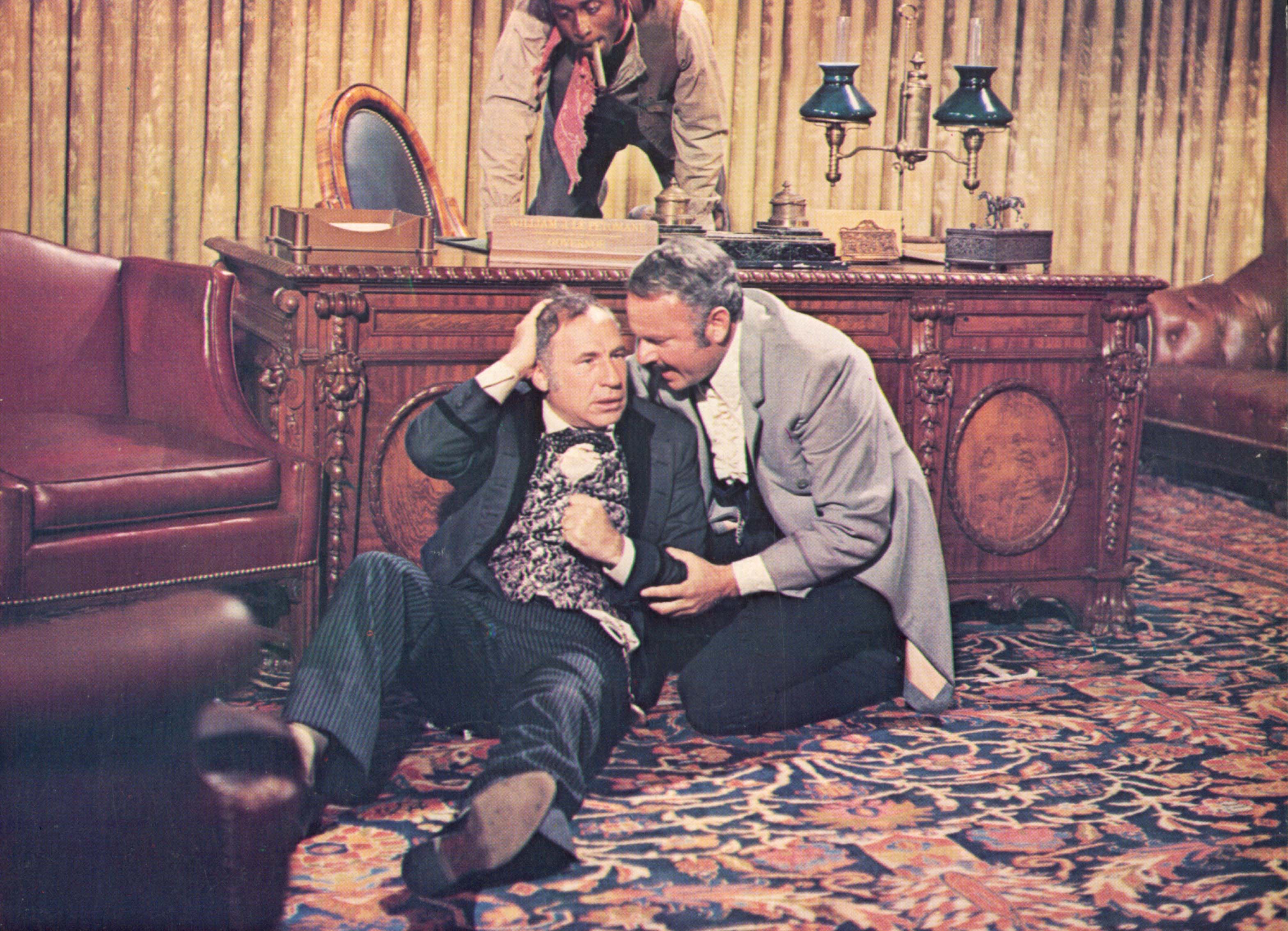Blazing Saddles at 50: Against all odds, Mel Brooks created the wackiest western ever made
The director’s groundbreaking satire of bigotry had a wild journey to the screen, with drugs in the writers’ room and attempts to prohibit almost all of its controversial scenes. Martin Chilton looks back on how the creation, making and legacy of ‘Blazing Saddles’ were as anarchic as the film itself


Your support helps us to tell the story
From reproductive rights to climate change to Big Tech, The Independent is on the ground when the story is developing. Whether it's investigating the financials of Elon Musk's pro-Trump PAC or producing our latest documentary, 'The A Word', which shines a light on the American women fighting for reproductive rights, we know how important it is to parse out the facts from the messaging.
At such a critical moment in US history, we need reporters on the ground. Your donation allows us to keep sending journalists to speak to both sides of the story.
The Independent is trusted by Americans across the entire political spectrum. And unlike many other quality news outlets, we choose not to lock Americans out of our reporting and analysis with paywalls. We believe quality journalism should be available to everyone, paid for by those who can afford it.
Your support makes all the difference.It was “too dirty” for John Wayne to accept a part. Too “disgusting and vulgar” for Ted Ashley, the chairman of Warner Brothers, who threatened to “bury” the film. But director Mel Brooks stuck to his guns, refusing to make edits, and was vindicated. Blazing Saddles, 50 this February, was a massive hit, one Brooks declared “the funniest motion picture ever”.
The story of the creation, making and legacy of Blazing Saddles is as anarchic as the movie itself. The idea for a film about Sheriff Bart, a Black dandy who saves a town of rednecks from an unscrupulous developer and his violent henchmen, came in 1972 from a young screenwriter, Andrew Bergman, who had recently completed a PhD in American movie history. Warners asked Brooks to flesh out Bergman’s 30-page “skeletal outline” for a western called Tex-X.
Brooks, then 46, was unemployed and “absolutely broke”, despite the acclaim for his 1967 movie The Producers. His actress wife Anne Bancroft was expecting their first child. He leapt at the chance to write and direct “the wackiest, most insane movie ever made”, one that lampooned racism and spoofed the westerns he watched growing up as Max Kaminsky in Williamsburg, New York.
The screenwriting team led by Brooks included Bergman, Norman Steinberg, Alan Uger and the volatile comic Richard Pryor. Brooks, clearly a fan of the superlative, described the late Pryor as “the greatest stand-up comedian who ever lived”, albeit one with demons and a ferocious appetite for Rémy Martin. Pryor, who once saw his mother tear open his father’s testicles during a fight at the family-run brothel, was also a drug addict, who had snorted cocaine with jazz trumpeter Miles Davis. When Pryor offered a vial to Brooks during a writing session, the director joked, “Me? Never before lunch.”
To Warner Brothers, Pryor was “a known sniffer” (in Brooks’s words) and, following a drugs arrest, they flatly rejected the proposal that the “uninsurable” comedian play Black Bart, the sheriff of frontier town Rock Ridge. Pryor and Brooks auditioned about 100 actors until being captivated by Cleavon Little, a Broadway star Brooks described as “this beautiful, sculptured, laidback man”. Pryor was blunter. “I’m coffee-coloured and have a moustache, I look Cuban,” he told Brooks. “That mother****er is so Black; he’s gonna scare the s*** out of that town.’”
For the white screenwriters, the racist slurs were a problem. However, Pryor was adamant they must use the “N” word – and frequently. “We are writing a story of racial prejudice. That’s the word, the only word. It’s profound, it’s real, and the more we use it from the rednecks, the more the victory of the Black sheriff will resonate,” he said. The result was a groundbreaking satire of bigotry, with the sophisticated Bart (he has a Gucci saddlebag) deftly exposing the stupidity of the white racists. When a chain-gang boss demands a “good old n***** work song”, the Sheriff and his Black co-workers croon Cole Porter’s “I Get No Kick from Champagne”. The punchline is that the white cowboys end up in a ludicrous demonstration of how to sing and dance to “De Camptown Races”. Later, when the townsfolk want to shoot Bart, he escapes by holding a gun to his own throat and faking a surreal self-hostage situation. “Oh, baby, you’re so talented... and they are so dumb,” he remarks.
The most unsettling moment, though, is when Bart meets a resident from Rock Ridge, the sort of bonnet-wearing, sweet-looking old lady who is a stereotype of the western, and she yells: “Up yours, n*****!” in his face. When Bart returns to his sheriff’s office, his drunken gunslinger deputy Jim the Waco Kid (Gene Wilder) notices his crestfallen face and says, “These people are the common clay of the New West… you know… morons.” Brooks said that line always got the biggest laugh from cinema audiences, who were sampling the big screen’s first interracial buddy comedy.

Wilder was hired by chance. Brooks originally cast Gig Young, an Oscar winner for 1969’s They Shoot Horses, Don’t They?, after being told the star was in recovery. Brooks joked that he was delighted to hire “a real old alkie”. Sadly, after one attempt at his first scene, Young began screaming, shaking and spewing green vomit, and had to be taken away in an ambulance. Brooks rang Young’s manager and quipped, “He ain’t quite recovered.” Gigs later filed a $100,000 suit for damages but was reportedly unsuccessful. Wilder answered Brooks’s plea to replace Young and flew straight to California from New York. He learned lines on the plane and was magnificent, without a single rehearsal.
One lawsuit that did earn a payout was to the Golden Age actress Hedy Lemarr, who took exception to Brooks’s scheming attorney general Hedley Lamarr (played by Harvey Korman) and the running joke over his name. In June 1974, she filed a $10,000,000 suit for invasion of privacy and exploiting her name without permission. “We settled out of court,” Brooks admitted. “It wasn’t a lot, a couple of thousand dollars. I apologised to her for ‘almost using your name’… I don’t think she got the joke.”

Watch Apple TV+ free for 7 days
New subscribers only. £8.99/mo. after free trial. Plan auto-renews until cancelled

Watch Apple TV+ free for 7 days
New subscribers only. £8.99/mo. after free trial. Plan auto-renews until cancelled
Another running gag was around the gargantuan subliterate thug Mongo, played by former Detroit Lions American football star Alex Karras. Pryor wrote witty dialogue for Mongo’s scenes, including Jim’s advice to Bart, “Don’t shoot him, it will just make him mad.” Pryor also penned the poignant line when, gazing up with puppy eyes, the hulking outlaw says, “Mongo only pawn in game of life.”
The farting scene has to go. You can’t punch a horse. You can’t hit an old lady. And you can’t use the ‘N’ word
Mongo’s most famous scene, however, was knocking down a horse with one mighty punch, after riding into town on a Brahman bull. Brooks had been told by comedian Sid Caesar about the time he slugged an unruly horse between the eyes. The screenwriter stored the anecdote away. Brooks said he got about a thousand letters of complaint from animal lovers, even though it was a horse trained to fall when the stunt ride pulled back on the bridle, before contact with Mongo’s fist.
The supporting cast – including Slim Pickens, David Huddleston, Burton Gilliam, Madeline Kahn and bandleader Count Basie (playing himself in a funny music scene in the desert) – were superb. Brooks had fun playing a Native American chief who talks with a Yiddish accent, and the lecherous, cross-eyed Governor William J Le Petomane (named after the 19th-century Frenchman Le Pétomane, whose whole act was based on flatulence). One of the most cutting moments in the film is when Le Petomane praises the “fair” scheme to give Indigenous Indians a box of paddleball toys in exchange for duping them out of 200,000 acres of their land.

Perhaps the most celebrated scene in the film, though, is when a band of outlaws sit around a campfire eating beans. They belch and fart loudly for over a minute. Brooks asked a friend about the edginess of the scene and was told, “If you are going up to the bell you better ring it.” Brooks was asked in 2016 whether Blazing Saddles could have been made in the 21st century. “I don’t think so, no,” he replied. “Maybe you could get away with the campfire scene with the farting. I think you could. But I don’t think you could ever get away with the “N” word being done by so many white people so many times.”
Although the film is a terrific parody of racism and small-mindedness – and full of clever inside jokes, routines, sight gags and homages about iconic westerns such as High Noon, Looney Tunes cartoons, vaudeville acts, Busby Berkeley dance routines and William Shakespeare’s Henry V – it is less clear how much the casual homophobia (with repeated use of slurs) is there to also expose redneck prejudice or whether it’s simply another dismal example of a vile pejorative from a backward time.
Right up to the final editing process, Brooks played with the title. After rejecting Tex-X, he proposed Black Bart and then The Purple Sage (Warners thought it was “too arcane”) before having a “Eureka!” moment in the shower and coming up with Blazing Saddles. Bancroft told him “it doesn’t make any sense”, but Brooks insisted, “It says western and it says crazy.”
After the infamous screening for Warner executives, Ashley told Brooks to axe 26 scenes, ordering him to write on a legal pad: “The farting scene has to go. You can’t punch a horse. You can’t hit an old lady. And you can’t use the ‘N’ word.” “If I cut those we’d have a 15-minute film,” Brooks later said. “I wrote it all down and then, after he walked out, I crumpled up the pages and tossed them in the wastepaper bin.” Co-writer Steinberg had an even starker memory of the clash, telling AV Club: “We showed the film to the Warner office workers. And they went bats***. People were falling on the floor – because it was so outrageous at the time. And Mel said, ‘F*** ’em, this is our film,’ and that was the film that was released.”
Blazing Saddles had its world premiere on 7 February 1974, at the Pickwick Drive-In Theatre in Burbank, and the 250 guests – including Little and Wilder – arrived on horseback. The movie became Warner’s top moneymaker that summer, grossing $16,500,000. Brooks received $50,000 “for all the writing, directing and sweeping up”. The film received three Oscar nominations: for film editing, best song (“Blazing Saddles” was written by Brooks and John Morris and sung by Frankie Laine, who had sung on the classic Gunfight at the OK Corral) and for Kahn as Best Supporting Actress (playing Lili Von Shtüpp).
The film is not available on streaming outlets and rare television showings are usually the bowdlerised version that Brooks decries as having been “cut by prudes”. Seek out the original. Half a century on, Blazing Saddles stands as a remarkable comedy. “The film allowed me to be the lovely Rabelaisian vulgarian that I am,” Brooks said proudly.
Join our commenting forum
Join thought-provoking conversations, follow other Independent readers and see their replies
Comments